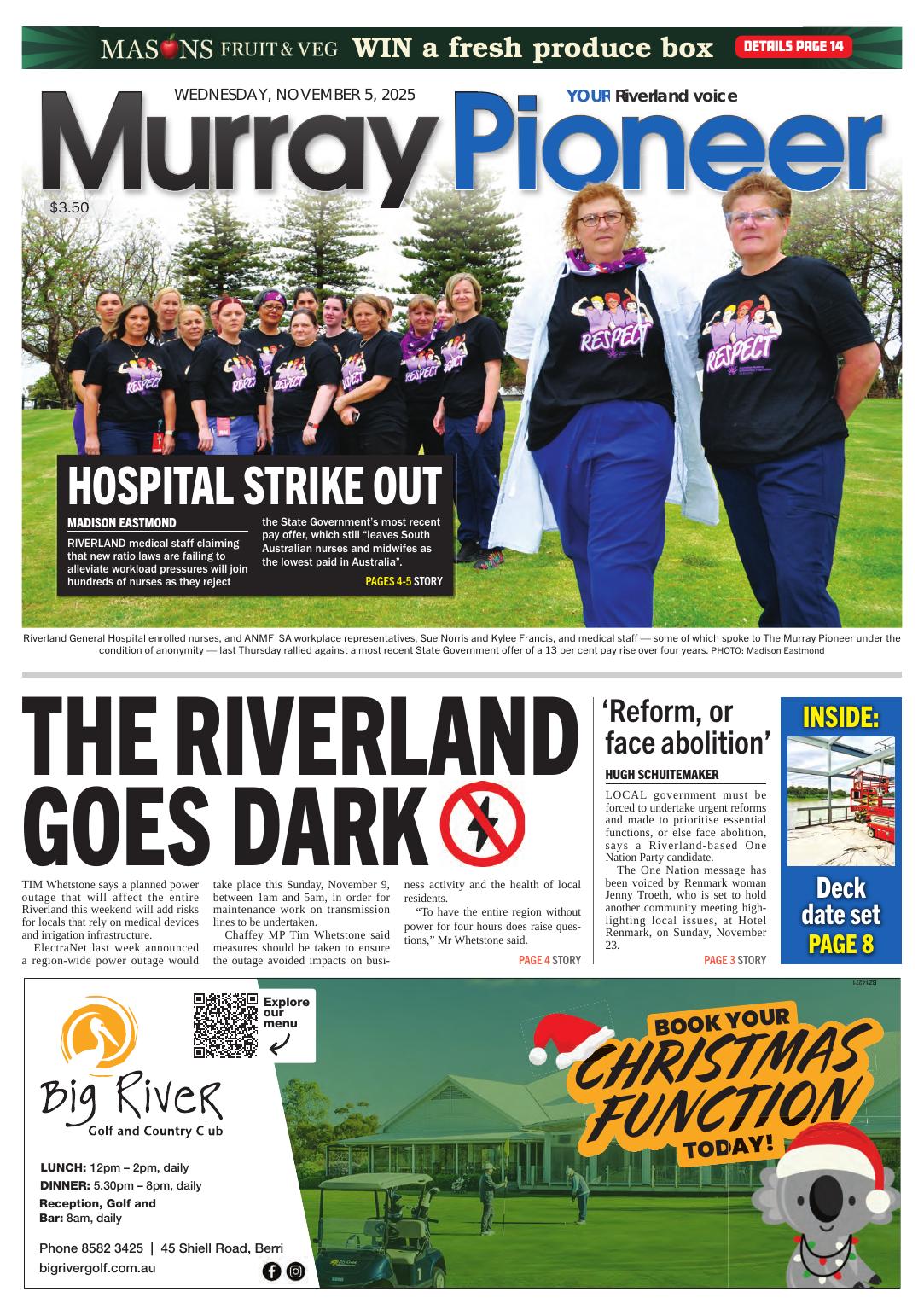Madison Eastmond, Murray Pioneer
Riverland medical staff are claiming new ratio laws that have been recently passed by the State Government to improve medical care and safety are failing to alleviate the “high pressure working conditions” of rural and regional healthcare.
Alongside an offer of a 13 per cent pay rise over four years, with bonus payments totalling $4500 — that the Australian Nursing and Midwifery Federation (ANMF) SA branch responded to with a Parliament House rally last week — the State Government also announced the passing of new patient ratio laws, which are said to ensure “safer nursing”.
Though modelled on Victorian ratios, and constructed under “extensive consultation” with ANMF SA, striking nurses and midwives from the Berri-based Riverland General Hospital — speaking to The Murray Pioneer under the condition of anonymity — claimed the ratios were not efficient for rural and regional hospitals, and in fact, only enforcing and maintaining current workload pressure.
“(While) the union has been great… with their strong focus on pay rise, for us as regional and rural nurses, (the strike) is also about working conditions which haven’t been addressed yet — these patient ratios do nothing to help us,” a staff member said.
“Not only can we not retain staff (due to wage amount), but the high-pressure working conditions are making nurses leave the profession because they’re so stressed and burnt out.”
Passing the laws in October, Adelaide’s four largest hospitals — the Royal Adelaide Hospital, Flinders Medical Centre, Lyell McEwin Hospital, and Women’s and Children’s Hospital — will be required to have one nurse for every four patients during day shift, and one in eight patients for night shifts, with other metropolitan hospitals receiving the same ratios bar in the afternoon, which requires one nurse every five patients.
However, for large regional general hospitals, the requirements are one nurse for every five patients during morning shift, one nurse for every six patients during afternoon shift, and one nurse for every 10 patients during night shift, with smaller regional hospitals required to be staffed with at least one registered nurse, and one other nurse or midwife on all shifts.
For midwives, the mother and the baby are considered one patient.
While Minister for Health and Wellbeing Chris Picton said the laws and proposed raise were part of “a major win for South Australian patients, nurses and midwives”, an additional Riverland General Hospital staff member said the new offerings showed the government “does not know what (rural) nurses do” day-to-day, and were “cruel.”
“(Politicians) get on the news and say we support nurses, but then they do this,” they said.
“Metro nurses only have worry about completing their nurse shift duty while caring for their patients. We have to do everything on top of our normal load.
“In metro, they have services built in, such as cleaners, (ward assistants), and phlebotomists — however, here, we have to (additionally) strip and clean the rooms, wash and feed patients, transport patients, take blood, assisting doctors, changing pads, wound care, and more.
“Five patients may not seem like a lot, but it is, especially when you have to do every single thing for them — you also need to remember, these are all sick people… three out of my five are often bed bound.
“Also, in Adelaide, they have separate wings — and orthopaedic wing, a maternity wing, a rehab wing, here, it’s all together.
“(My patient ratio could include) taking care someone from orthopaedics, someone from rehab, as well as someone who is acutely sick.
“You can understand why they can’t retain staff — students do their placement here, and they don’t return, and agency nurses come here once, and they never come back.”
“They’re cutting corners to save a buck, and we’re the ones that wear the consequences.
“To me it seems like (the Government thinks) this amount of work is not worthy of a pay rise, it’s just horrible, and it’s cruel.”
A staff member who also worked across smaller Riverland SA Health sites, such as the Barmera Health Service, said the small ratio laws were exacerbating issues of understaffing and overwhelming workloads.
“We only ever have two nurses on during a single shift,” they said.
“However, if a one nurse has to attend the emergency department — which is also going 24/7 — a nurse can be left with up to 11 patients.
“However, (at the Regional General Hospital) emergency department patients are admitted on top of patient ratios.
“They try to share (the workload) around, but it’s hard — especially as they struggle to get staff numbers up on the days where there are high patient numbers.
“You just have to put up with it and just work it. What else can you do?”
“(The State Government) have thrown us under the bus.
“They always put country (services) in the ‘too hard basket’ — they address city concerns, and we are just getting left further and further behind.
This article appeared in Murray Pioneer, 5 November 2025.
Related story: Hospital strike out

